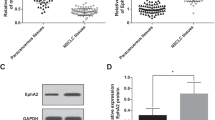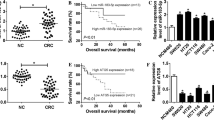Abstract
Purpose
This study set out to probe into the effect and mechanism of miR-144-3p on radiosensitivity of gastric cancer (GC) cells.
Methods
Cancer tissue and paracancerous tissue of GC patients admitted to our hospital were collected, their miR-144-3p expression was tested, GC cells were transfected, and survival and biological behavior of those cells under radiation were detected.
Results
After detection, miR-144-3p expression was down-regulated in GC tissue, while ZEB1 was up-regulated. There was no remarkable difference in the survival fraction of cells in each group before receiving radiation, but that of tumor cells decreased obviously (p < 0.05) after radiation exposure. Survival fraction of cells overexpressing miR-144-3p or silencing ZEB1 decreased more obviously, while the inhibition of miR-144-3p or overexpressing ZEB1 was weaker. Biological behavior of cells under 6 Gy radiation was detected. It was found that miR-144-3p overexpression or silencing ZEB1 dramatically inhibited the proliferation activity of GC cells under 6 Gy radiation, increased the levels of pro-apoptotic Bax and caspase-3 proteins (p < 0.05) and decreased the anti-apoptotic protein Bcl-2 level (p < 0.05), resulting in an increase in the apoptosis rate of cells. miR-144-3p was confirmed to be ZEB1 targeting site by dual luciferase report. Moreover, rescue experiments prove that it can increase the radiosensitivity of GC cells by regulating ZEB1 expression.
Conclusion
miR-144-3p expression was down-regulated in GC, and it can increase the radiosensitivity of those cells by inhibiting ZEB1 expression.





Similar content being viewed by others
References
Van Cutsem E, Sagaert X, Topal B, Haustermans K, Prenen H. Gastric cancer. Lancet. 2016;388:2654–64.
Li T, Mo X, Fu L, Xiao B, Guo J. Molecular mechanisms of long noncoding RNAs on gastric cancer. Oncotarget. 2016;7:8601–12.
Sitarz R, Skierucha M, Mielko J, Offerhaus GJA, Maciejewski R, Polkowski WP. Gastric cancer: epidemiology, prevention, classification, and treatment. Cancer Manag Res. 2018;10:239–48.
Zhang H, Sun LL, Meng YL, Song GY, Hu JJ, Lu P, Ji B. Survival trends in gastric cancer patients of Northeast China. World J Gastroenterol. 2011;17:3257–62.
Zhao EH, Ling TL, Cao H. Current status of surgical treatment of gastric cancer in the era of minimally invasive surgery in China: opportunity and challenge. Int J Surg. 2016;28:45–50.
Tan Z. Recent advances in the surgical treatment of advanced gastric cancer: a review. Med Sci Monit. 2019;25:3537–41.
Liu JS, Che XM, Chang S, Qiu GL, He SC, Fan L, Zhao W, Zhang ZL, Wang SF. beta-elemene enhances the radiosensitivity of gastric cancer cells by inhibiting Pak1 activation. World J Gastroenterol. 2015;21:9945–56.
Cai M, Chen Q, Shen J, Lv C, Cai L. Epigenetic silenced miR-125a-5p could be self-activated through targeting Suv39H1 in gastric cancer. J Cell Mol Med. 2018;22:4721–31.
Zhu C, Huang Q, Zhu H. miR-383 inhibited the cell cycle progression of gastric cancer cells via targeting Cyclin E2. DNA Cell Biol. 2019;38:849–56.
Wu J, Zhao Y, Li F, Qiao B. MiR-144-3p: a novel tumor suppressor targeting MAPK6 in cervical cancer. J Physiol Biochem. 2019;75:143–52.
Liu F, Chen N, Xiao R, Wang W, Pan Z. miR-144-3p serves as a tumor suppressor for renal cell carcinoma and inhibits its invasion and metastasis by targeting MAP3K8. Biochem Biophys Res Commun. 2016;480:87–93.
Cheng ZX, Song YX, Wang ZY, Wang Y, Dong Y. miR-144-3p serves as a tumor suppressor by targeting FZD7 and predicts the prognosis of human glioblastoma. Eur Rev Med Pharmacol Sci. 2017;21:4079–86.
Li B, Zhang S, Shen H, Li C. MicroRNA-144-3p suppresses gastric cancer progression by inhibiting epithelial-to-mesenchymal transition through targeting PBX3. Biochem Biophys Res Commun. 2017;484:241–7.
Li LY, Yang CC, Yang JF, Li HD, Zhang BY, Zhou H, Hu S, Wang K, Huang C, Meng XM, Zhou H, Zhang L, Li J, Xu T. ZEB1 regulates the activation of hepatic stellate cells through Wnt/beta-catenin signaling pathway. Eur J Pharmacol. 2019;865:172787.
Zhang P, Sun Y, Ma L. ZEB1: at the crossroads of epithelial-mesenchymal transition, metastasis and therapy resistance. Cell Cycle. 2015;14:481–7.
Qin Y, Tang B, Hu CJ, Xiao YF, Xie R, Yong X, Wu YY, Dong H, Yang SM. An hTERT/ZEB1 complex directly regulates E-cadherin to promote epithelial-to-mesenchymal transition (EMT) in colorectal cancer. Oncotarget. 2016;7:351–61.
Song Z, Li W, Wang L, Jia N, Chen B. MicroRNA-454 inhibits tumor cell proliferation, migration and invasion by downregulating zinc finger Eboxbinding homeobox 1 in gastric cancer. Mol Med Rep. 2017;16:9067–73.
Zhou X, Wang Y, Shan B, Han J, Zhu H, Lv Y, Fan X, Sang M, Liu XD, Liu W. The downregulation of miR-200c/141 promotes ZEB1/2 expression and gastric cancer progression. Med Oncol. 2015;32:428.
Tanioka H, Nagasaka T, Uno F, Inoue M, Okita H, Katata Y, Kanzaki H, Kuramochi H, Satake H, Shindo Y, Doi A, Nasu J, Yamashita H, Yamaguchi Y. The relationship between peripheral neuropathy and efficacy in second-line chemotherapy for unresectable advanced gastric cancer: a prospective observational multicenter study protocol (IVY). BMC Cancer. 2019;19:941.
Kim S, Kim JE, Kim N, Joo M, Lee MW, Jeon HJ, Ryu H, Song IC, Song GY, Lee HJ. Decursin inhibits tumor growth, migration, and invasion in gastric cancer by down-regulating CXCR7 expression. Am J Cancer Res. 2019;9:2007–188.
Zhang X, Zheng L, Sun Y, Wang T, Wang B. Tangeretin enhances radiosensitivity and inhibits the radiation-induced epithelial-mesenchymal transition of gastric cancer cells. Oncol Rep. 2015;34:302–10.
Tsubouchi K, Minami K, Hayashi N, Yokoyama Y, Mori S, Yamamoto H, Koizumi M. The CD44 standard isoform contributes to radioresistance of pancreatic cancer cells. J Radiat Res. 2017;58:816–26.
Alfonso JCL, Berk L. Modeling the effect of intratumoral heterogeneity of radiosensitivity on tumor response over the course of fractionated radiation therapy. Radiat Oncol. 2019;14:88.
Borrego-Soto G, Ortiz-Lopez R, Rojas-Martinez A. Ionizing radiation-induced DNA injury and damage detection in patients with breast cancer. Genet Mol Biol. 2015;38:420–32.
Li Y, Qin C. MiR-1179 inhibits the proliferation of gastric cancer cells by targeting HMGB1. Hum Cell. 2019;32:352–9.
He Y, Jing Y, Wei F, Tang Y, Yang L, Luo J, Yang P, Ni Q, Pang J, Liao Q, Xiong F, Guo C, Xiang B, Li X, Zhou M, Li Y, Xiong W, Zeng Z, Li G. Long non-coding RNA PVT1 predicts poor prognosis and induces radioresistance by regulating DNA repair and cell apoptosis in nasopharyngeal carcinoma. Cell Death Dis. 2018;9:235.
Gao F, Liu P, Narayanan J, Yang M, Fish BL, Liu Y, Liang M, Jacobs ER, Medhora M. Changes in miRNA in the lung and whole blood after whole thorax irradiation in rats. Sci Rep. 2017;7:44132.
Song L, Peng L, Hua S, Li X, Ma L, Jie J, Chen D, Wang Y, Li D. miR-144-5p enhances the radiosensitivity of non-small-cell lung cancer cells via targeting ATF2. Biomed Res Int. 2018;2018:5109497.
Wang P, Yang Z, Ye T, Shao F, Li J, Sun N, He J. lncTUG1/miR-144-3p affect the radiosensitivity of esophageal squamous cell carcinoma by competitively regulating c-MET. J Exp Clin Cancer Res. 2020;39:7.
Zhang P, Wang L, Rodriguez-Aguayo C, Yuan Y, Debeb BG, Chen D, Sun Y, You MJ, Liu Y, Dean DC, Woodward WA, Liang H, Yang X, Lopez-Berestein G, Sood AK, Hu Y, Ang KK, Chen J, Ma L. miR-205 acts as a tumour radiosensitizer by targeting ZEB1 and Ubc13. Nat Commun. 2014;5:5671.
Kowalski-Chauvel A, Modesto A, Gouaze-Andersson V, Baricault L, Gilhodes J, Delmas C, Lemarie A, Toulas C, Cohen-Jonathan-Moyal E, Seva C. Alpha-6 integrin promotes radioresistance of glioblastoma by modulating DNA damage response and the transcription factor Zeb1. Cell Death Dis. 2018;9:872.
Shao M, Bi T, Ding W, Yu C, Jiang C, Yang H, Sun X, Yang M. OCT4 potentiates radio-resistance and migration activity of rectal cancer cells by improving epithelial-mesenchymal transition in a ZEB1 dependent manner. Biomed Res Int. 2018;2018:3424956.
El Bezawy R, Cominetti D, Fenderico N, Zuco V, Beretta GL, Dugo M, Arrighetti N, Stucchi C, Rancati T, Valdagni R, Zaffaroni N, Gandellini P. miR-875-5p counteracts epithelial-to-mesenchymal transition and enhances radiation response in prostate cancer through repression of the EGFR-ZEB1 axis. Cancer Lett. 2017;395:53–62.
Jiang Y, Jin S, Tan S, Shen Q, Xue Y. MiR-203 acts as a radiosensitizer of gastric cancer cells by directly targeting ZEB1. Onco Targets Ther. 2019;12:6093–104.
Author information
Authors and Affiliations
Contributions
ZG is responsible for the conception or design of the work. ZG, HL and ZZ contribute the acquisition, analysis, or interpretation of data for the work. HL provides the tissue samples. ZG helps in the follow-up of the patients. HL helps in reviewing the histopathology slides. All authors finally approved the manuscript version to be published. ZG is the guarantor of the article.
Corresponding author
Ethics declarations
Conflict of interest
The authors declare that they have no conflict of interest.
Ethical approval
The study was approved by Ethical Committee of Binzhou Central Hospital and conducted in accordance with the ethical standards.
Informed consent
Yes.
Additional information
Publisher's Note
Springer Nature remains neutral with regard to jurisdictional claims in published maps and institutional affiliations.
Rights and permissions
About this article
Cite this article
Gao, Z.Y., Liu, H. & Zhang, Z. miR-144-3p increases radiosensibility of gastric cancer cells by targeting inhibition of ZEB1. Clin Transl Oncol 23, 491–500 (2021). https://doi.org/10.1007/s12094-020-02436-1
Received:
Accepted:
Published:
Issue Date:
DOI: https://doi.org/10.1007/s12094-020-02436-1




